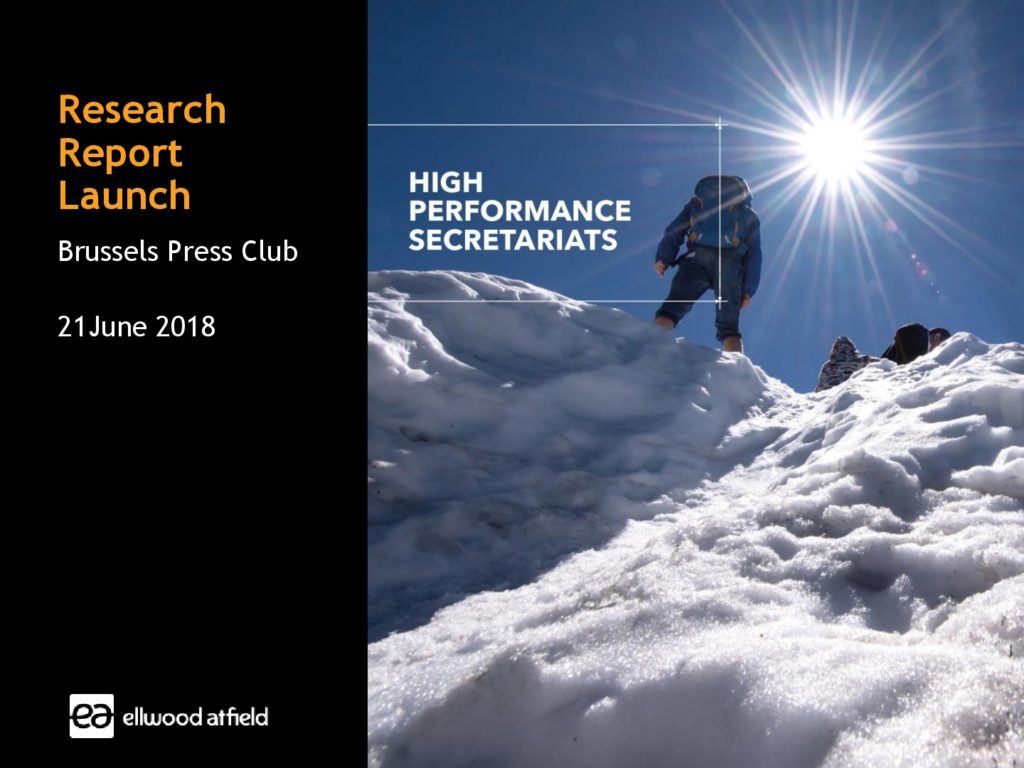
Press Club, 21st June 2018
Summary Report
Dr Rachel Barlow moderated the session and introduced the speakers in turn.
Mark Dober began by presenting the new Ellwood Atfield research on “High Performing Secretariats” (see attached powerpoint). He initially focused on the 7 key attributes of such a secretariat stating that these were:
- Individual accountability;
- Shared responsibility;
- Open communication;
- Participative leadership;
- Mutual trust;
- Proactive and responsive; and
- Aligned on strategy.
He pointed to the fact that dysfunctional secretariats paid little attention to results and counted members who were not committed to the overall success of the team. Mark provided attributes of successful leaders and underlined the need for participative leadership where team members were also empowered and shared successes together.
But how can one measure the performance of your team? There were three sources for this; membership satisfaction surveys, policy and communication outcomes and measuring against key performance indicators.
Mark then described the approach of the report in assessing secretariats. This rested on the application of the above 7 criteria and that of an association leader combined with criteria to ascertain effectiveness. These were provided as; output, collaborative ability and individual development.
He moved on to underline the cost of poor staff and noted that they can create damage by upsetting internal and external stakeholders or costing the association poor policy outcomes. If one has to fire a staff member, there are heavy related costs and time lost in on-boarding the new hire. He advised recruiting top people.
Earlier Ellwood Atfield research on what makes good advocates led to the identifying of three components; personality, knowledge and skills. Leading personality traits for lobbyists were being;
- trustworthy and agreeable;
- proactive and conscientious;
- resilient and opinionated.
Finally, Mark pointed to the last survey results to enumerate the key factors that retained high performers in their jobs. The top three factors were a “flexible work schedule”, “new responsibilities” and “good annual salary rises”. The three factors that most contributed to people leaving their jobs were “not learning and growing in their careers”, “knowledge and skills”, “failure to provide a framework within which the employee perceives he/she can succeed and poor leadership or supervision”.
Rachel then introduced Marijke Van den Bossche and Sigrid de Vries from the association of automotive suppliers, CLEPA (see attached powerpoint).
The association is in the process of a change management exercise created and led by Marijke and Sigrid. The team composition, pro-activeness and collaboration had been substantially improved and this work was still on-going.
In brief, Sigrid first described how the secretariat moved to interacting units for the greater effectiveness of the team to better support the mission of the organisation. Each team member now worked under a service title of Advocacy and Market Support, Technology Solutions and Regulations or Operations and Communications.
Marijke then focused on how the improvements across the organisation were devised and implemented. She first referred to the basic concepts (slides 10 and 11) before going through the main steps and tools used which included membership and staff satisfaction surveys, recruitment and revamping the job descriptions, providing coaching and seeking to set up a dynamic, flexible and happy team.
The outcomes of the overall exercise proved very worthwhile including clarity on expectations and targets, greater personal leadership and accountability, increased motivation and “better feelings, better results”.
They then turned to the lessons learned, with emphasis on co-creation meaning that the team members participated in setting the direction of their activities. Marijke advised using new colleagues as levers to bring about change and the need for exemplary leadership on the part of the Secretary General. Finally, Sigrid pointed out that the Board had fully supported the exercise from the outset, which had been essential to well implement the strategy.
Paul Voss of Euroheat and Power was then introduced as the last speaker who entertained the participants with his approach based on “serendipity”. Paul describes himself as a glass “half full person” and admits to being maybe more relaxed than some of his staff members. Indeed, he was grateful to staff members who were worriers since they pulled the alarm bells and galvanised action. He noted that any change in a secretariat (with a nod to CLEPA’s excellent work) had to be undergone whilst work is ongoing, and this constituted a challenge in itself.
He holds regular weekly meetings with the staff and encourages open communication with him. He noted the importance of making everyone feel valued and part of the team.
The session was a bit short on time so only a brief discussion took place. The need to include the administrative factors of “work from home” and co-related insurance matters in the secretariat considerations was generally agreed on.
Also, in support of Marijke’s methodology, one of the measures of success of the CLEPA change exercise was when the secretariat members themselves included the leadership in their informal gatherings.
All presenters were thanked for their valuable and detailed contributions.


